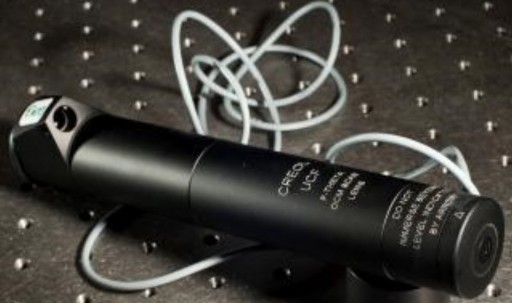A new high-resolution method for imaging below the skin using a liquid lens
February 21, 2011

This prototype device may eliminate the need for many biopsies to detect skin cancer. (J. Adam Fenster)
University of Rochester optics professor Jannick Rolland has developed an optical technology that provides unprecedented images under the skin’s surface.
The aim of the technology is to detect and examine skin lesions to determine whether they are benign or cancerous without having to cut the suspected tumor out of the skin and analyze it in the lab. Instead, the tip of a roughly one-foot-long cylindrical probe is placed in contact with the tissue, and within seconds a clear, high-resolution, 3D image of what lies below the surface emerges.
Rolland presented her findings at the 2011 annual meeting of the American Association for the Advancement of Science in Washington, D.C., on Feb. 19.
“My hope is that, in the future, this technology could remove significant inconvenience and expense from the process of skin lesion diagnosis,” Rolland says. “When a patient walks into a clinic with a suspicious mole, for instance, they wouldn’t have to have it necessarily surgically cut out of their skin or be forced to have a costly and time-consuming MRI done. Instead, a relatively small, portable device could take an image that will assist in the classification of the lesion right in the doctor’s office.”
The device accomplishes this using a unique liquid lens setup developed by Rolland and her team for a process known as Optical Coherence Microscopy. In a liquid lens, a droplet of water takes the place of the glass in a standard lens. As the electrical field around the water droplet changes, the droplet changes its shape and therefore changes the focus of the lens. This allows the device to take thousands of pictures focused at different depths below the skin’s surface. Combining these images creates a fully in-focus image of all of the tissue up to 1 millimeter deep in human skin, which includes important skin tissue structures. Because the device uses near infrared light instead of ultrasounds, the images have a precise, micron-scale resolution instead of a millimeter-scale resolution.
The process has been successfully tested in in-vivo human skin and several papers on it have been published in peer-reviewed journals. Rolland says that the next step is to start using it in a clinical research environment so its ability to discriminate between different types of lesions may be assessed.
Adapted from materials provided by the University of Rochester